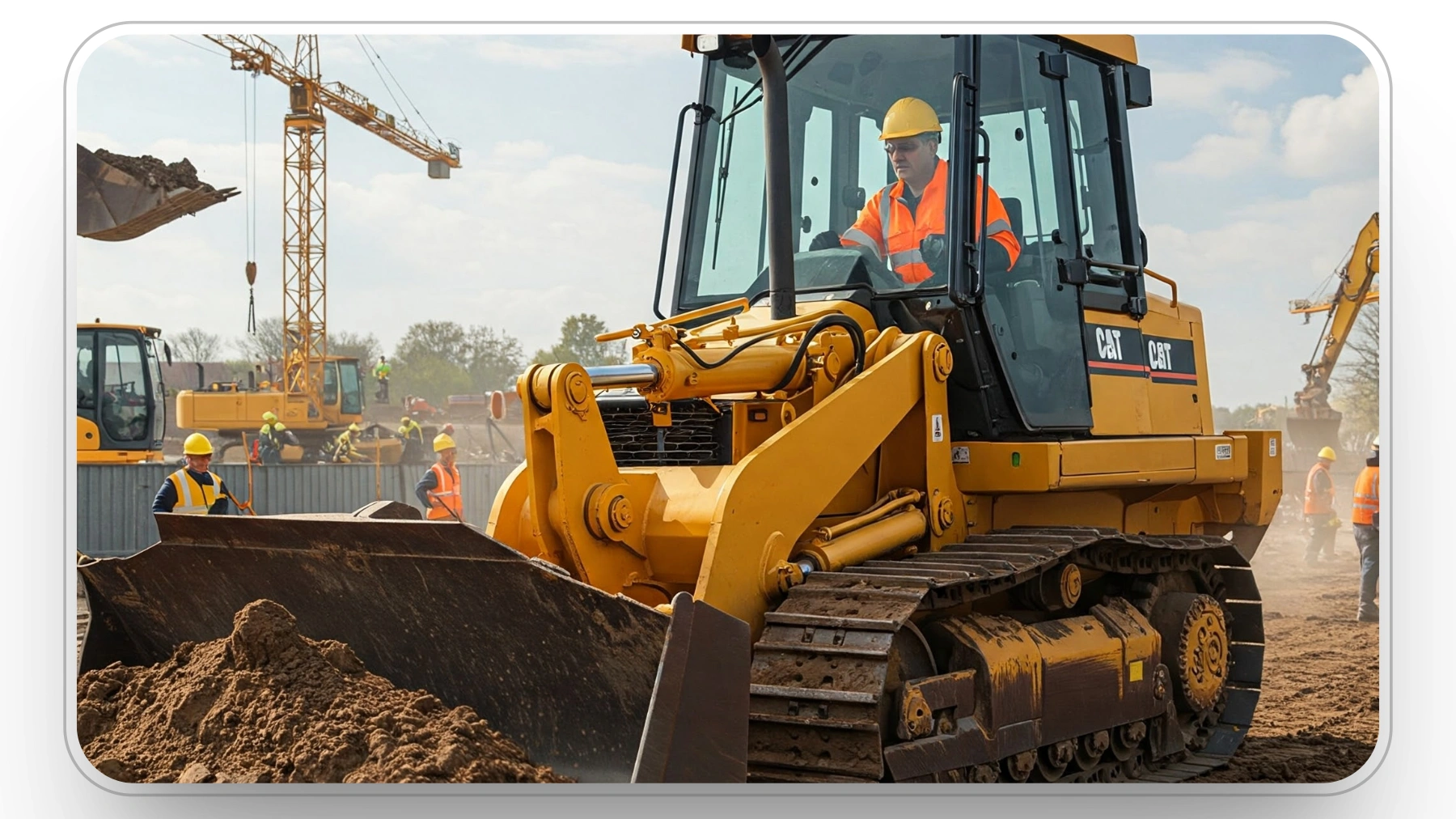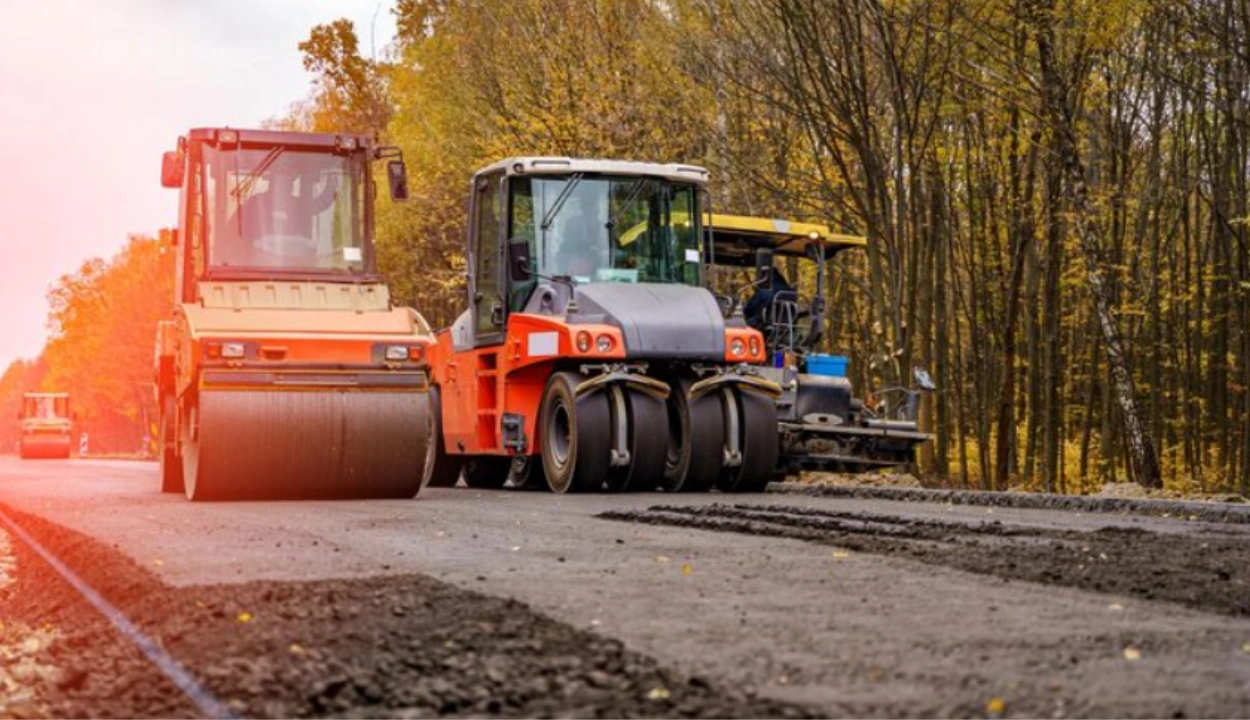What equipment are needed for a construction site?
The rapid expansion of commercial and industrial development has led to a significant rise in global construction equipment demand. Industry research indicates that the construction equipment market was valued at USD 149.7 billion in 2023 and is projected to reach USD 194.7 billion by 2030, driven by expanding infrastructure investments and advancements in heavy machinery.
Whether you operate a small construction firm or manage large-scale developments, having the right equipment is essential for maintaining efficiency, safety, and productivity on-site. This article highlights the most essential construction equipment categories every project needs and explains how each contributes to smooth and successful project execution.
Let's discuss the most popular equipment used at construction sites and their importance for the smooth development of construction projects.
Key Equipment Needed for a Construction Site
The following table summarizes the most critical construction site equipment by category before we dive deeper into each one.
Essential Equipment used on a construction site
Having the right equipment transforms construction projects from challenging tasks into streamlined operations. Let's explore each category in detail to understand what makes these tools essential for modern construction sites.
Heavy Machinery
1. Excavators
Excavators are the backbone of earthworks, pairing a 360° rotating house with a powerful boom-stick-bucket for precise trenching, foundations, and demolition. Quick-change couplers let you swap buckets for breakers, augers, or grapples, so the same machine can dig, shear, or sort. Choose compact minis for urban utility work, or full-size crawlers for bulk excavation.
Track shoes, undercarriage guarding, and auxiliary hydraulics should match soil and task. Plan truck matches (bucket passes per load) to keep haul fleets busy and idle time low. Grand View Research estimates the global excavator market at USD 75.85B (2023), projecting USD 108.37B by 2030 (approximately 5% CAGR), reflecting sustained demand tied to infrastructure and utilities.
2. Dozers/Bulldozers

Dozers excel at pushing, ripping, and finish grading, using powerful engines and blade control to shape pads, build berms, and clear overburden. Match straight (S), universal (U), or semi-U blades to your material type; add rippers for hardpan and frost. Wide tracks reduce ground pressure for soft soils; narrow shoes improve traction on firm ground. Grade control (2D/3D GNSS) reduces rework and surveys, especially on long runs.
Look for auto-idle, slope assist, and telematics to reduce fuel consumption and catch maintenance needs early. Recent market analyses place the global bulldozer segment in steady single-digit growth through 2032 as roadbuilding and mining expand.
3. Tower Cranes
Tower cranes provide vertical reach and radius for high-rise lifting, with mast sections climbed as the structure grows. Luffing and flat-top variants suit tight urban sites; load-moment indicators and anti-collision systems protect workers and structures. Proper counterweighting, foundation design, and wind limits are essential for stability. Plan hook time and crane zoning early to avoid trade bottlenecks.
Manufacturer specs illustrate typical capabilities: modern units offer approximately 70m jib with approximately 32t max capacity (e.g., Terex CTL 702-32) and end-of-jib capacities around 6t; freestanding heights vary by configuration.
4. Backhoe Loaders
Backhoe loaders combine a front loader for stockpile work with a rear excavator for trenching ideal where crews need mobility without a low-boy trailer. Side-shift booms, extendable dippers, and 4-in-1 buckets expand capability for utilities and municipal jobs. Road legality and quick travel speeds make them efficient for multi-stop service work.
Specify pilot controls for operator comfort, return-to-dig automation for faster cycles, and stabilizers sized for ground conditions. Analysts report backhoe loader demand growing mid-single to high-single digits through 2030 as urban maintenance and small-site construction continue.
5. Dump Trucks
Dump trucks move spoil, aggregates, and debris quickly, using hydraulic tipping bodies to shorten cycle times. Match body volume to material density to avoid overloading; use liners for wet clay and heated bodies for asphalt. On-highway tandems and tri-axles serve plant-to-site hauling, while articulated and rigid off-highway trucks handle rough mass-haul.
Fleet sizing depends on loader match, haul distance, grade, and ground conditions. The global dump truck market is projected to reach approximately USD 102.1B by 2030, driven by construction and mining adoption of modern drivetrains and safety technology.
6. Motor Graders
Motor graders deliver precise finish on subgrades and unpaved roads with a mid-mounted moldboard, circle drive, and precise articulation. Pair front-mounted scarifiers for reshaping and mid-mount rippers for hard surfaces.
Six-wheel drive and diff-locks improve traction on steep, loose material. Integrate 2D/3D grade control to reduce stakes and passes, especially for crowned roads and drainage. Market researchers forecast steady growth (approximately 5% CAGR) in graders through 2030, supported by resurfacing and rural-road programs.
7. Wheel Loaders
Wheel loaders excel at short-cycle truck loading and stockpile management, with Z-bar or parallel-lift linkages to favor breakout or fork handling. Payload scales and auto-lift kickout keep cycles consistent. Quick couplers support buckets, forks, grapples, and brooms for all-season utility.
Urbanization keeps loader demand strong; Global Market Insights estimates the wheel loader market over USD 14.3B (2023) with over 4% CAGR to 2032, as construction and quarrying expand.
8. Rollers (Drum Rollers)
Single-drum padfoot rollers compact cohesive soils; smooth-drum vibratory units densify granular bases and asphalt. Dual-drum rollers deliver even mats on thin lifts, while oscillatory drums help near structures. Intelligent compaction measures stiffness in real time, reducing over-rolling and fuel consumption.
For earthworks, tune amplitude and frequency to layer thickness and soil type; for asphalt, manage mat temperature, pattern, and rolling windows. Analysts place the road-roller segment on a moderate growth path as pavement preservation accelerates.
9. Pavers
Asphalt pavers meter HMA from the hopper via augers, then pre-compact with a heated screed for smooth, even thickness. Material transfer vehicles help keep a continuous supply of material and reduce thermal segregation. Automation (grade & slope sensors, 3D systems) improves ride quality and drainage.
Plan paving trains with the correct screed width, joint strategy, and roller train. Industry reports show the paver market growing as highway rehabilitation increases post-pandemic, reaching approximately USD 2B+ globally in 2023.
Power and Hand Tools
.webp)
1. Generators
Construction power plans depend on starting currents and duty cycles size for peak loads plus a 20–30% reserve to avoid power trips. Choose single- or three-phase, set proper grounding, and separate clean power circuits for electronics. Fuel strategy (diesel, gasoline, LPG) should reflect runtime, emissions, and site rules.
The portable generator segment is projected at USD 4.96B (2024), reaching USD 6.78B by 2030, reflecting backup power needs and jobsite electrification. Include GFCI protection and weather-rated distribution for compliance.
2. Concrete Mixers
On-site mixers provide schedule control for footings, patches, and short-haul pours; batch carefully to the water-cement ratio and keep drums clean to avoid contamination. For frequent pours, consider towable or skid mixers with hydraulic dump and calibrated paddles. Check aggregate moisture content and adjust water accordingly to maintain proper slump.
Market estimates place concrete mixers at approximately USD 3.5B in 2023 with approximately 5%+ CAGR toward 2032, tracking global infrastructure and residential work. Where specifications permit, use admixtures for workability and hot-/cold-weather placement.
3. Power Tools
Cordless platforms (Li-ion) now rival corded power for drilling, fastening, and cutting; shared battery ecosystems simplify logistics. Brushless motors, electronic clutches, and anti-kickback improve control when drilling concrete or cutting metal. Dust extraction attachments support silica compliance.
The global power-tools market was approximately USD 32.95B (2024) and could reach USD 54.5B by 2030, driven by infrastructure and productivity demands. Standardize batteries and chargers across trades to reduce idle time.
4. Hand Tools
Well-made hand tools hammers, chisels, pliers, squares, and levels deliver accuracy where power tools can't, especially for layout and finish. Choose insulated tools for electrical work and hardened cutting edges for metal work.
Protective sheaths and shadow boards reduce injuries and loss. Routine inspection catches damaged chisels and cracked handles before they fail. Calibrated levels and tapes maintain tolerances on finish work; ergonomic grips reduce fatigue over long shifts.
Safety and Site Equipment
1. Personal Protective Equipment (PPE)
Head protection is mandatory where impact hazards exist; modern safety helmets include suspension, chin straps, and accessory rails for face shields and ear muffs. Select type/class based on electrical exposure and impact profile. Replace after major impacts or when shells degrade from UV.
OSHA requires employers to ensure appropriate head protection on construction sites (29 CFR 1926 Subpart E). See OSHA's guidance for selection and use details (29 CFR 1926.95).
2. Site Barriers and Fencing
Temporary fencing, jersey barriers, and controlled access points separate the public from hazards and protect assets after hours. Use debris netting and toe boards at elevations and lockable gates for equipment yards.
Coordinate with traffic plans to keep emergency routes open. Document inspections for wind damage and stability; repair compromised panels immediately. Signage at entries should state PPE requirements and authorized access rules.
3. Safety Signage
Consistent, multilingual signage communicates hazards (DANGER/WARNING/CAUTION), mandatory PPE, restricted areas, and emergency egress. Use durable materials and maintain visibility with adequate lighting.
Update signs as site phases change old or conflicting notices reduce compliance. Pair signage with toolbox talks so crews understand the "why," not just the symbol.
4. Fire Safety Equipment
Select and place extinguishers based on hazard class (A/B/C/D/K) and travel-distance rules; train crews on PASS (pull-aim-squeeze-sweep). Inspect monthly for pressure, pins, and corrosion; perform annual service and hydro tests per schedule. NFPA 10 is the governing standard for selection, installation, inspection, and maintenance of portable extinguishers; typical guidance targets ≤75 ft travel distance to an extinguisher in many occupancies.
Material Handling Equipment
1. Forklifts
Forklifts move palletized loads quickly; rough-terrain variants handle uneven surfaces with larger tires and higher ground clearance. Choose mast height, free lift, and carriage type for your racking and door clearances; add sideshifts and fork-positioners for precision.
The global forklift market is estimated at USD 72.6B (2024) and may reach approximately USD 155B by 2030, reflecting logistics growth and electrification. Daily inspections brakes, chains, hydraulics are critical to safe operation.
2. Conveyor Systems
Belt, screw, and telescoping conveyors move aggregates, concrete, and demolition debris with fewer manual touches. Guard pinch points, install emergency stops, and plan for spill control at transfer points to maintain housekeeping and reduce slip hazards.
Conveyors work well for repetitive, mid-distance moves and elevation changes that slow down loader cycles. Modular designs let you redeploy lines as the site phases, preserving capital.
3. Trailers
Trailers move equipment and materials between sites; choose deck height, axle count, and tie-down points for expected loads. Low-boys carry compact excavators and skid steers; flatbeds handle bundles of rebar, lumber, and prefab panels; enclosed trailers protect tools and consumables.
Verify weights, securement (chains/straps, working load limits), and over-dimension permits before travel. A solid transport plan reduces idle time and ensures the right equipment arrives when crews need it.
How to Maintain Equipment on a Construction Site
Maintaining construction equipment is essential to ensure smooth operations and reduce costly breakdowns. Below are key maintenance practices and how Clue helps make the process more efficient:
- Daily Inspections: Operators should check engine oil, hydraulic systems, tire pressure, and coolant levels daily. Clue can automate inspection reminders and track completion in real time.
- Follow Manufacturer Guidelines: Regular oil changes, filter replacements, and lubrication are essential. Clue stores maintenance records and automates notifications for scheduled services, ensuring timely upkeep.
- Preventive Maintenance: Proactively check hydraulic hoses, calibrate instruments, and inspect fuel systems. Clue’s maintenance alerts help schedule and track preventive tasks, reducing downtime.
- Track Usage and Performance: Monitor data like fuel consumption and idle time to predict maintenance needs. Clue provides performance insights, helping optimize equipment use and identify potential issues early.
- Predictive Maintenance: By analyzing performance data, Clue can help predict when equipment will need servicing, reducing unplanned downtime and maintenance costs.
How Clue Helps Manage Construction Equipment

Clue is a digital platform that simplifies construction equipment management and maintenance. By using real-time tracking and data analytics, Clue helps construction teams keep equipment running smoothly and efficiently.
With Clue, you can monitor where your equipment is, how it's being used, and spot maintenance needs before problems happen. This helps reduce downtime, enhance safety, and maximize equipment utilization.
Key Features:
- Equipment Tracking: Monitor every machine in real time with GPS and usage data, reducing idle time, preventing losses, and improving equipment allocation.
- Maintenance Alerts: Get automatic notifications when service is due or an issue is detected to prevent breakdowns and costly delays.
- Maintenance Scheduling: Plan and track maintenance tasks easily. Clue keeps full service records, so no inspection or repair gets missed.
- Safety and Compliance: Stay compliant by tracking inspections, certifications, and maintenance logs, ensuring all equipment meets safety standards.
- Insights and Dashboards: Access data-driven reports on equipment usage, downtime, and fuel trends to improve efficiency and control costs.
Conclusion
Construction equipment plays a critical role in every stage of a project from site preparation to finishing work. Each machine and tool, whether a towering crane or a precision hand tool, contributes to efficiency, safety, and quality on-site.
As the global construction equipment market continues to grow, investing in the right machinery has become essential for companies of all sizes. Understanding how to select, operate, and maintain equipment effectively not only reduces downtime but also enhances safety and ensures projects are delivered on schedule.
Whether you’re managing a small residential build or a large commercial development, the proper use and maintenance of construction equipment form the foundation of successful, cost-efficient, and safe project execution.
FAQs
What is the most essential heavy equipment for a construction site?
Excavators are the most versatile, handling digging, trenching, demolition, and material handling. However, the essential equipment depends on your project type. Most contractors consider excavators, loaders, and dump trucks as the core trio for general construction.
Should I buy or rent construction equipment?
Buy if you'll use the equipment 60-70% of the time or more. Rent for occasional use, specialized equipment, or short-term projects to avoid maintenance costs, storage expenses, and depreciation. Many contractors own core equipment while renting specialized machines.
What safety equipment is legally required on construction sites?
OSHA requires a minimum of hard hats, safety glasses, and appropriate footwear. High-visibility vests are mandatory near vehicular traffic. Additional PPE depends on specific hazards: hearing protection for noise, respirators for dust/fumes, and fall protection for work above six feet.
How often should construction equipment be maintained?
Daily pre-operation inspections are essential. Follow manufacturer recommendations for preventive maintenance, typically oil changes every 250-500 hours, hydraulic oil annually, and regular filter replacements. Heavy-use equipment needs more frequent servicing to prevent costly breakdowns.
What is the difference between a backhoe and an excavator?
Excavators are larger, more powerful, with 360-degree rotation, and are designed primarily for heavy excavation. Backhoes are smaller, combining a front loader and rear excavator with 180-200 degree swing. Backhoes excel at smaller projects requiring both loading and digging; excavators handle heavy-duty work.
How do I choose the right generator for my construction site?
Calculate the total wattage of all tools running simultaneously, add their ratings, and include a 20-30% buffer. Consider single-phase vs. three-phase power based on your equipment. Choose fuel type based on runtime needs and site restrictions. Consult an electrician for proper sizing.
Transform Your Equipment Management












